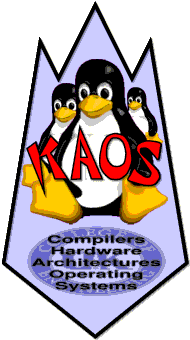

You've probably seen video walls before -- every Disney store has one. What is so special about ours is the fact that each is driven by a supercomputing cluster of Linux PCs. What does that mean? Well, for example, consider our cluster of 16 AMD K6-2 PCs:

As you can see, it uses 16 17" monitors to display images up to 6,400x4,800 pixels... that is about 80 times better resolution than a DVD. In fact, it's better than the best IMAX movies.
Not only can it display such big images, but it also can generate or manipulate them -- it is, after all, a supercomputer capable of 22.5 billion floating-point operations per second (22.5GFLOPS)! That's about 1/100th the speed of the fastest supercomputer in the world... at about 1/5000th the cost.
But wait, you say, I thought the cluster was just a bunch of K6-2 PCs? Yup. What you might not have realized is that the 3DNow! instructions AMD put into the K6-2 so you could play Doom and Quake also can be used for "serious" computing, if you have the right compiler technology... and guess what we developed? Ok, don't guess; just look here.
The computer geeks among you also might be wondering about how we make these machines work together. "Is this one of those Beowulf Clusters that we keep hearing about?" Well, actually, while our group was based at Purdue, we built the first Linux PC cluster. We even wrote the book on how to do it (ok, I'm really talking about the Parallel Processing HOWTO). Beowulf was just the name of an early Linux cluster in a national lab... actually, we called one of our first SpareParticus.
Back to the question about how the PCs work together, which is really asking what kind of interconnection network we use. We use both Fast Ethernet and a little custom hardware called PAPERS, which we also developed. Ethernet is used for transmitting big blocks of data, but our PAPERS network is up to thousands of times faster than any other network for coordinating the processors. Yes, I said any network. Even the custom hardware inside the world's fastest supercomputers is far slower at what we call aggregate function communication... and you can build our custom hardware from our designs (they are fully public domain) for less than $100 per PC connected.
In case you had not yet guessed, the KAOS lab is about achieving great computing speeds and enabling new types of computer applications... by making all the parts of a computing system work better together. We're computer engineers who spend our time in careful design and implementation of interactions between Compilers, Hardware Architectures, and Operating Systems. That's CHAOS, except we make it KAOS because we're in Kentucky and we also like the obscure reference to the "Get Smart" TV show. Anyway, we work to create, demonstrate, and disseminate technologies that can improve performance or provide new capabilities by integrating different aspects of computer system design.
You can find out more about the KAOS lab's work from its home page or from Professor Dietz's home
page. Feel free to contact us with any questions you might
have. Please come see us in 672 Anderson Hall
on Engineering Day, February 26, 2000...
and stare at our walls for a while. ;-)